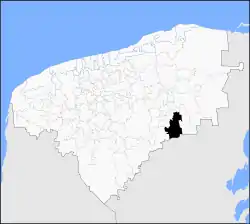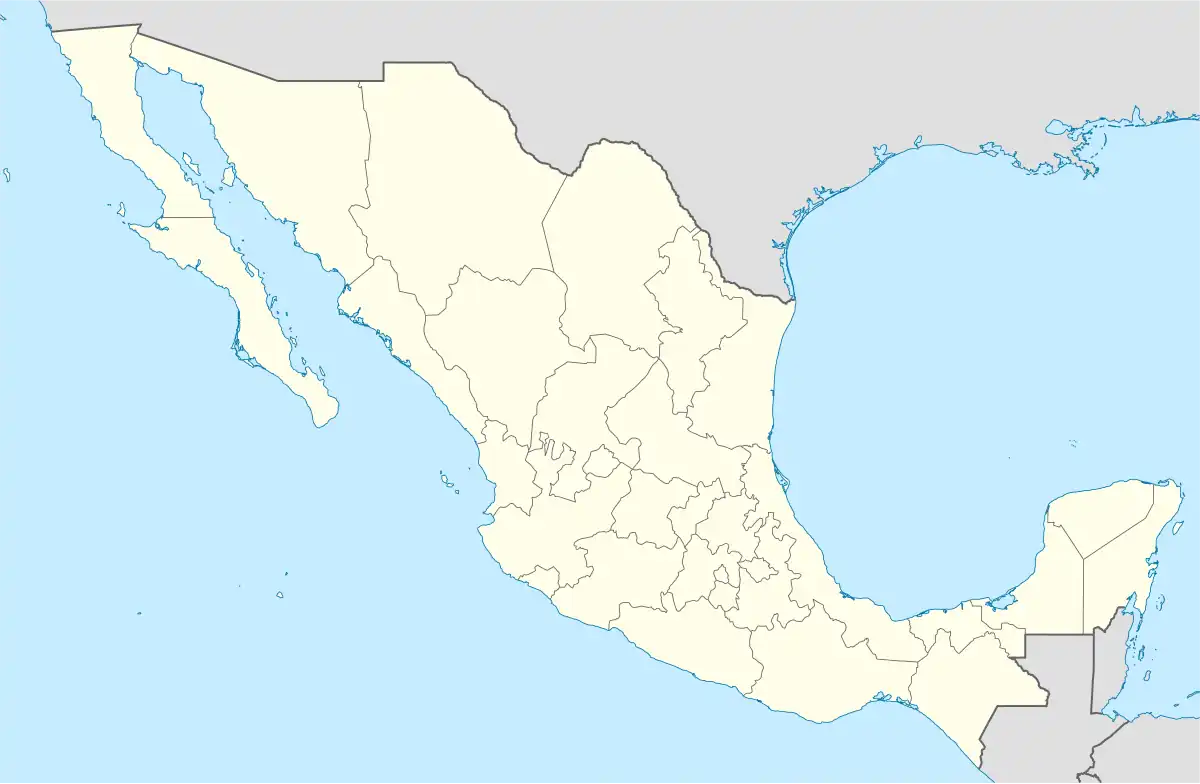Tixcacalcupul | |
|---|---|
 Region 6 Oriente #092 | |
 Tixcacalcupul Location of the Municipality in Mexico | |
| Coordinates: 20°32′12″N 88°16′13″W / 20.53667°N 88.27028°W | |
| Country | |
| State | |
| Mexico Ind. | 1821 |
| Yucatán Est. | 1824 |
| Government | |
| • Type | |
| • Municipal President | Leonardo Chay Ek[2] |
| Area | |
| • Total | 1,164.98 km2 (449.80 sq mi) |
| [2] | |
| Elevation | 27 m (89 ft) |
| Population (2010[3]) | |
| • Total | 6,665 |
| • Density | 5.7/km2 (15/sq mi) |
| • Demonym | Umanense |
| Time zone | UTC-6 (Central Standard Time) |
| • Summer (DST) | UTC-5 (Central Daylight Time) |
| INEGI Code | 092 |
| Major Airport | Merida (Manuel Crescencio Rejón) International Airport |
| IATA Code | MID |
| ICAO Code | MMMD |
| Municipalities of Yucatán | |
Tixcacalcupul Municipality (Yucatec Maya: "Two mouths of Cupul's well") is one of the 106 municipalities in the Mexican state of Yucatán containing (1,164.98 km2) of land and is located roughly 180 kilometres (110 mi) southeast of the city of Mérida.[2]
History
There is no accurate data on when the town was founded, but it was a settlement before the conquest and was located in the chieftainship of Cupules. After colonization, the area became part of the encomienda system with various encomenderos,[2] beginning with Francisco Manrique in 1549, passing to Juan de Cárdenas in 1579, Francisco Mallén in 1607 and later to Francisco Mallén de Rueda. In 1645 the encomenderos were Gaspar de Ayala Pacheco and Francisca Dorantes y Solís and in 1686 passed to Pedro Pardo de Lagos.[4]
Yucatán declared its independence from the Spanish Crown in 1821 and in 1825[5] the area was assigned to the Valladolid Municipality. During the Caste War of Yucatán, a battle occurred here in which almost all of the inhabitants were massacred by government troops. In 1918 the area became its own municipality.[2]
Governance
The municipal president is elected for a three-year term. The town council has four councilpersons, who serve as Secretary and councilors of public works, sports, education and health.[6]
Communities
The head of the municipality is Tixcacalcupul, Yucatán. The municipality has 28 populated places[6] besides the seat including Ekpedz, Mahas, Poop, San José and X-Tohbil. The significant populations are shown below:[2]
| Community | Population |
|---|---|
| Entire Municipality (2010) | 6,665[3] |
| Ekpedz | 1235 in 2005[7] |
| Mahas | 377 in 2005[8] |
| Poop | 437 in 2005[9] |
| San José | 466 in 2005[10] |
| Tixcacalcupul | 3207 in 2005[11] |
| X-Tohbil | 307 in 2005[12] |
Local festivals
Every year on 15 June the town celebrates the feast of Saint Bartholomew the Apostle.[2]
Tourist attractions
- Archeological site at Xai Bei
References
- ↑ "Presidentes Municipales" (in Spanish). Mérida, Mexico: PRI yucatan. 23 January 2014. Retrieved 15 August 2015.
- 1 2 3 4 5 6 7 "Municipios de Yucatán »Tixcacalcupul" (in Spanish). Retrieved 15 August 2015.
- 1 2 "Mexico In Figures:Tixcacalcupul, Yucatán". INEGI (in Spanish and English). Aguascalientes, México: Instituto Nacional de Estadística y Geografía (INEGI). Archived from the original on 6 May 2015. Retrieved 15 August 2015.
- ↑ García Bernal, Manuela Cristina (1978). Población y encomienda en Yucatán bajo los Austrias (in Spanish). Sevilla: Escuela de Estudios Hispano-Americanos. p. 519. ISBN 978-8-400-04399-5. Retrieved 15 August 2015.
- ↑ "Estado de Yucatán. División Territorial de 1810 a 1995" (PDF). inegi (in Spanish). Aguascalientes, Mexico: Instituto Nacional de Estadística, Geografía e Informática. 1996. p. 15. Archived from the original (PDF) on 2015-12-23. Retrieved 15 August 2015.
- 1 2 "Tixcacalcupul". inafed (in Spanish). Mérida, Mexico: Enciclopedia de Los Municipios y Delegaciones de México. Retrieved 15 August 2015.
- ↑ "Ekpedz" (in Spanish). PueblosAmerica. 2005. Retrieved 15 August 2015.
- ↑ "Mahas" (in Spanish). PueblosAmerica. 2005. Retrieved 15 August 2015.
- ↑ "Poop" (in Spanish). PueblosAmerica. 2005. Retrieved 15 August 2015.
- ↑ "San José" (in Spanish). PueblosAmerica. 2005. Retrieved 15 August 2015.
- ↑ "Tixcacalcupul" (in Spanish). PueblosAmerica. 2005. Retrieved 15 August 2015.
- ↑ "X-Tohbil" (in Spanish). PueblosAmerica. 2005. Retrieved 15 August 2015.
